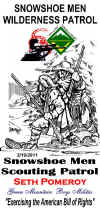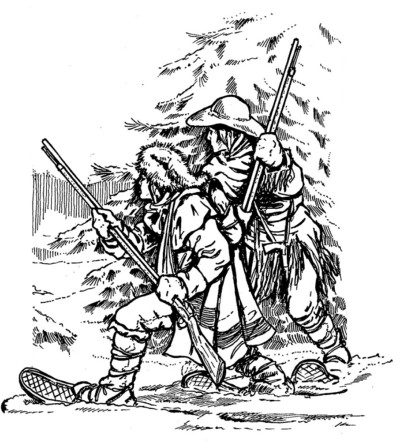|
Snow Shoe Men - "small, well-armed
patrols ranging through the winter forest on snow shoes". (
The Minutemen. The First Fight: Myths and Realities of the American
Revolution, by: John R. Galvin, at page 21)
__________________________________________
February, 2011
Snowshoe Men Patrol -
Winter Recon
Event date: 2/21/2011
(completed): Snow
Shoe Men Scouting Patrol. Event was a 2 man sharpshooter team / recon
patrol (Sharpshooter and spotter / Green Mountain Boys Militia*). Started
snowing. Weather was cold. Snow was powdery. This was a short distance
snow shoe patrol. Engaged 100 yard target / hit. *Experiencing
American History, the U.S. Constitution, and U.S. Bill of Rights through
re-enactments, education and marksmanship.
Event date: 2/27/2011
(completed): Snow
Shoe Men Scouting Patrol. Event was a 2 man sharpshooter team / recon
patrol (Sharpshooter and spotter / Green Mountain Boys Militia*). Winds
gusts 5 to 15 MPH. Target distance: 100 yards. Target size: 5".
Shooting positions wearing snowshoes: Prone, Standing, and Kneeling. Snow
approximately 3 feet deep and powdery. Weather started changing; sky
turning black. It was a great time! Celebrating American Liberty. *Experiencing
American History, the U.S. Constitution, and U.S. Bill of Rights through
re-enactments, education and marksmanship.
Sample of another future planned event (two man teams):
2 mile round trip Rifle carry with backpack. Engage 100 yard and 200 yard
targets.
Tactical
Intervention Specialists Slip Cuff Quick Release Sling
HSGI
Waist Pack
Medical
Kit
Historical
Background Information:
COLONIAL
COMMANDOS
The nation's first elite forces helped
tame an early frontier, but it's their winter footwear that marks their
place in U.S. military history
By Bob Haskell
November 2010
Three hundred years ago, before the authors of the Declaration of
Independence were even born, the American frontier was not out west but
much closer to the Atlantic coast, in places like western Massachusetts
and what is now Maine and New Hampshire.
At the time, this was a harsh, unsettled land full of Indians, who, along
with their French Canadian allies, aggressively contested—often
preemptively—any hint of westward expansion by English colonists.
For their protection, many colonial villages formed militias. But
settlements along New England’s frontier required more than your average
able-bodied men. They needed especially strong, fierce men who could
muster quickly and take the fight to the enemy.
This need for elite forces spawned the creation of small units that became
known as “snowshoe men.” They patrolled the frontier, protecting
settlements from attacks. They operated in all types of weather and
conditions. This included winter campaigns, which were conducted on
snowshoes, and the name stuck.
The snowshoe men were the nation’s first commandos. They were rangers
decades before Rogers’ Rangers gained fame during the French and Indian
War. They were minutemen long before the colonial Minutemen reaped renown
early into the Revolutionary War.
But mostly they were Indian fighters, often turning the Indian’s tactics
against them. And they were paid bounties for a grisly product—Indian
scalps, according to retired General John R. Galvin in his 1967 book The
Minute Men.
“The colonists had learned … that the Indians were most vulnerable in
the wintertime, because they disliked traveling in the bad weather and
because they could be tracked over the snow to their unguarded
villages,” he wrote.
“With this in mind, the colonists decided to fight the Indians with
small, well-armed patrols ranging through the winter forest on snow shoes
[sic].”
SCALP HUNTING
Life on the New England frontier in the early 1700s was as perilous as it
was in more storied parts of this country, such as Arizona and Texas and
across the Great Plains, more than a century later.
In 1703, more than 500 Indians and a handful of Canadians ravaged New
England settlements from what is now Portland, Maine, to Haverhill in
Massachusetts in 1703. More than 160 settlers were killed or taken
prisoner.
A year later, a force of 200 French, French-Canadian and Indian raiders
attacked Deerfield, Mass., killing more than 50 men, women and children.
Massachusetts fought back. Leaders put a price on the Indians’ heads,
originally between 10 and 50 pounds for each scalp, according to Galvin.
The price was eventually increased to 100 pounds per scalp, he added.
“The reward for scalps was more attractive than grisly to men of the
western Massachusetts towns, hardened as they were by the ravages of the
Indians, and there were many men anxious to take to the forest trails in
this new occupation of scalp hunting,” the general wrote.
Scouting parties began ranging the woods throughout the year. Snowshoe
companies were formed of men who lived on the frontier and who could be
called into service on short notice—the early minutemen.
Their area of operations was something of an arc across western and
northern New England, extending from Springfield, Mass., to the Kennebec
River in the District of Maine. Thirteen companies, for example, were
ready to fight in the outlying regions of Worcester, Hampshire, Middlesex
and York counties by 1745, and a line of fortifications were built to
provide patrol bases, Galvin explained.
The region featured level land in the Connecticut and Merrimack river
valleys and more mountainous, heavily forested terrain in what is now
southern New Hampshire and western Maine. The snowshoe men patrolled when
conditions allowed and hunkered down when the snow was too deep or the
cold too bitter.
“Could not go out with snow shoes nor without. Snow deep 4.50 feet,”
wrote one Capt. Samuel Wright on Dec. 4, 1724, in his Scouting
Journal that was displayed last winter at the Massachusetts
Archives. “Came in being extreme cold,” wrote Wright eight days later
about his scouting around Brookfield, Mass.
British Captain John Lovewell of Dunstable, now Nashua, N.H., was one of
the snowshoe men’s fiercest leaders. He led two expeditions during the
winter of 1724-25 that ranged as far north as the White Mountains,
according to historic reports.
One raid, in February 1725, thwarted a suspected attack on frontier
settlements by Abenaki Indians who were armed with French muskets.
Lovewell’s men killed and scalped 10 of the Indians, and they paraded
the scalps through Boston that March.
Lovewell was killed by an Abenaki warrior in May 1725 during another
expedition. He was 33. His wife and children were given tracts of land in
New Hampshire, and Lovewell Mountain in that state and Lovewell Pond in
Fryeburg, Maine, are named after that snowshoe man.
WRONG WAR
The snowshoe men accomplished their mission of subduing the Indians during
the first half of the 18th century.
“Throughout this period the snowshoe men kept the northern and western
borders relatively quiet,” Galvin wrote.
“During the winter, little or no spoil was done on any of our frontiers:
the enemy being so terrified by reason of snow-shoes (most of our men were
skillful in) that they never considered coming in such a season after,”
stated colonial author Samuel Penhallow in his 1726 book Penhallow’s
Indian Wars.
Still, John Lovewell and the snowshoe men never gained the acclaim given
to Robert Rogers and his Rangers for their exploits during the French and
Indian War. By 1750, the snowshoe men had apparently faded into the forest
of history.
There are a couple of reasons for this.
They were organized during a relatively minor and little-known war. Queen
Anne’s War did not result in a conclusive victory. The French and Indian
War is far better known because it was a definitive victory for the
British and ended France’s control of Canada and the Midwest. Rogers’
Rangers, who operated primarily in the Lake George and Lake Champlain
regions of New York, fought for the winning side.
In addition, Rogers and the Rangers are still part of the Army tradition.
Rogers is considered the father of the modern Rangers. His modified 28
“Rules of Ranging” are still followed by the 75th Ranger Regiment. The
detachment of Rogers’ Rangers stationed at Fort Detroit is in the
lineage of the Michigan Army Guard’s 1st Battalion, 119th Field
Artillery.
The snowshoe men have their own legacy, however. Those companies are
directly linked to the Massachusetts Army Guard’s 1st Battalion, 181st
Infantry, according to Leonid Kondratiuk, the Massachusetts Guard’s
director of Historical Services.
And Galvin and Kondratiuk have pointed out that the Minuteman concept as a
well-trained and equipped light infantry force that could muster quickly
and move out to face the enemy was based in part on what the snowshoe
companies did to protect the English people in their new land.
Retired Master Sgt. Bob Haskell is a
freelance journalist in Falmouth, Mass. He can be contacted via [email protected].
|
